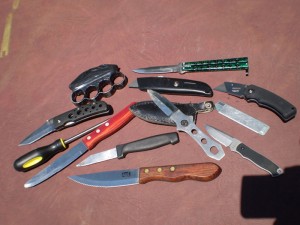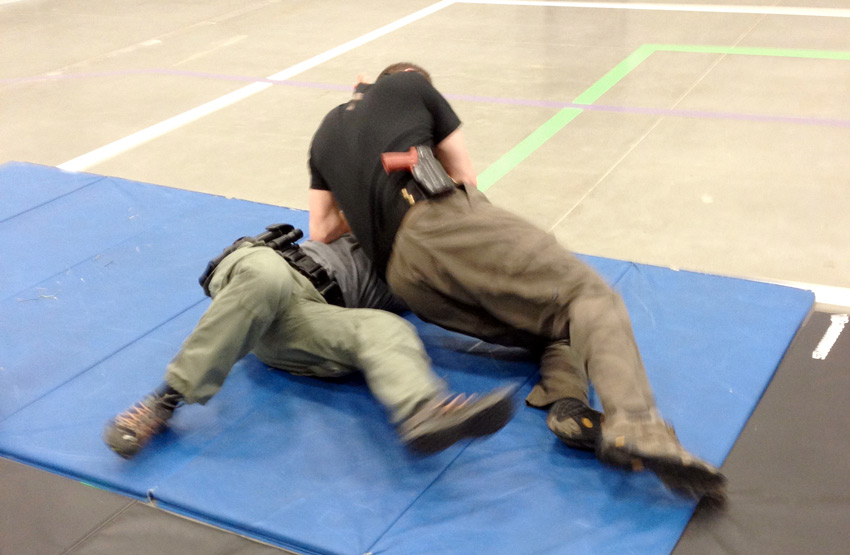Defending Against the Modern Edged Weapons Threat
Defending Against the Modern Edged Weapons Threat
Many people use the phrases “edged weapons” and “knife fighting” interchangeably. That is far from correct, or at least it is if you share the same definitions that I do.
Edged Weapons -Any tool that by design or improvisation can slash or penetrate human flesh.
Knife Fighting – Usually culturally inspired and traditionally taught interpersonal combat using fixed blade knives.
Regardless of which one you think of, lets look at the modern edged weapon threat and what you may encounter.
Selection
With the proliferation of folding knives, especially those with pocket clips, more and more people from every walk of life carry at least a small knife, this is true for the bad guys as well. Warehouse workers are notorious for always carrying box cutters and razor knives.
Not unlike the knives of many cultural martial arts, it makes sense to become proficient with the martial application of a tool you work with day in and day out. When fixed blades are encountered at the hands of offenders, there are of two major varieties. Screwdrivers (also burglary tools) and kitchen knives taken from home or restaurants. Most often found on offenders are heavy duty serrated steak knives with rounded tips, which allow safe carry without a sheath.
Carry and Deployment
 For offenders on the outside, it’s easier to carry a cheap folder or box cutter out in the open than it is to conceal something that could be uncovered during a normal stop and frisk. Weapons will most often be carried between the waist and nipple line, allowing access from different positions.
For offenders on the outside, it’s easier to carry a cheap folder or box cutter out in the open than it is to conceal something that could be uncovered during a normal stop and frisk. Weapons will most often be carried between the waist and nipple line, allowing access from different positions.
However, we’re going to discuss actual attacks, not brandishing or menacing at a distance as with robbery attempts. Even though the same mechanics are at play we’re also not going to discuss “assassination” attacks. First, we deal with the highest probable threat to most of us.
Attack during verbal dispute
Attacks are usually preempted by a verbal discourse. When offenders attack at “chest bumping” distance, it is seldom a calculated assault. Liken it to when you are pissed off and start shaking, then all of a sudden you erupt and pound your fist on the table. The key here is being educated on preparatory and executions movements, often loosely defined as furtive movement. We are dealing with contact distance weapons which means that to defend against an attack you have to be within contact distance.
In-fight weapon deployment
You are already involved in a physical altercation and your attacker deploys a weapon. Since you’re already in physical contact, you’re likely not in a position to see the weapon. This is why many victims report that they didn’t know they were being cut or stabbed, simply thinking they were being punched until the smoke cleared.
Use
Research tells us that the average length of a designed or improvised edged weapon will be sub four inches and will primarily be a stabbing or cutting tool, seldom both. Even when they are, adrenaline dump, anatomy and the mammalian stress response leads to cyclic stabbing or slashing more often then cutting patterns or angles. The good part about this is that a consistent angle of attack provides you with more opportunity for defense. The bad part is that not having to slow down to change angles allows for more powerful attacks.
Edged Weapon Survival 101
Your initial defense, if armed, will most likely be open hand. Open hand combatives use the hands, feet, torso and head as impact weapons. To effectively use these weapons lets talk about Combative Anatomy.
Central Nervous System – Comprised of the brain and spinal cord, this is the power strip and computer of the human body. It’s most efficiently compromised with impact weapons.
Circulatory System – Comprised of arteries and veins, this is the human body’s plumbing. It’s most efficiently compromised with penetrating attacks. This is likely to cause eventual death, but can be slow to stop violent action.
Structural System – Comprised of bones, muscles and ligaments, it’s most effectively compromised by impact weapons. Structural damage is seldom fatal yet can immediately stop an attack.
Using the above information we can logically see that open hand defense against edged weapons depends on compromising the Central Nervous and Structural Systems.
Law of Extension – States that for a person to attack you, they have to extend their arms, legs and head to you. This provides “hooks” and “touch points” for you to defend and control.
Principles of Defense
Move to the outside – Since 93% of people are right handed it is best to move to your left, their right. Get out from between their arms.
Controlling the arm – Focus on the mechanism of the attack, not the weapon. If you see one weapon, you’re dealing with one weapon. If you don’t see one you have to assume they haven’t deployed it yet. Control the leading arm by using your arms and body to maintain extension below the forearm and just above the elbow. This is best done with a push/pull movement, to hyper-extend/break the elbow. Also, train to keep your head up to increase power.
Find vertical surfaces or the ground – Once on the outside and working for control of the arm, do your best to put their head/face into a vertical surface or to the ground.
Strikes to the head – You will find that you’re now in a good position to use elbow strikes to the back and side of the head. Continue until the deadly threat is neutralized.
Training
In Modern Combative Systems classes we start off doing drills against the open hand, then training knives and then stun guns. The stun guns were added because when using training knives, people would get cut, quit, or fail to control their attacker until they were neutralized. Humans have a primal response to electricity. At the end of the day they have a clear understanding of what works and what doesn’t. Their responses are pressure tested.
Task – Don’t get cut or stabbed, or get cut or stabbed as little as possible.
Standard – Defend as efficiently as possible, and control the attacker.
Condition – You name it.
George “mercop” Matheis is a retired municipal police officer with a background in SWAT, patrol and training. He currently runs Modern Combative Systems, LLC which provides training in open hand combatives, impact weapons, edged weapons and firearms to citizens, military and Law Enforcement.









Discussion